History

 I have never been to the top of Mount Washington in New Hampshire, but I am intrigued by it, and by everything I have heard about it. Mount Washington is notorious for its erratic weather. On the afternoon of April 12, 1934, the Mount Washington Observatory recorded a windspeed of 231 miles per hour at the summit, the world record from 1934 until 1996. Mount Washington still holds the record for highest measured wind speed not associated with a tornado or tropical cyclone. Can you just imagine trying to stand outside in that wind? I can’t imagine trying to stand out in that wind, especially in winter, but I can imagine seeing that place…maybe not on a really windy day, but just to see the top would be very cool.
I have never been to the top of Mount Washington in New Hampshire, but I am intrigued by it, and by everything I have heard about it. Mount Washington is notorious for its erratic weather. On the afternoon of April 12, 1934, the Mount Washington Observatory recorded a windspeed of 231 miles per hour at the summit, the world record from 1934 until 1996. Mount Washington still holds the record for highest measured wind speed not associated with a tornado or tropical cyclone. Can you just imagine trying to stand outside in that wind? I can’t imagine trying to stand out in that wind, especially in winter, but I can imagine seeing that place…maybe not on a really windy day, but just to see the top would be very cool.
There are basically three ways to get to the top of Mount Washington. The first is to drive up on the Mount Washington Auto Road. If you choose this one, you can get one of the This Car Climbed Mount Washington  bumper stickers that are common throughout New England following your trip up the mountain, but to me that rather defeats the purpose reaching the summit. Now, if a person is an experienced hiker, there is a hiking trail to the top. And if you are really fanatical, you can hike it in Winter, taking the Snow Coach halfway up. Now, I like to hike, but definitely not in the Winter. One of the shortest, most scenic, and most popular trails to the summit is the 4.2-mile class 2 Tuckerman Ravine Trail that starts at the AMC Pinkham Notch Visitor Center (2050′). While 4.2 miles is doable, the class 2 part, meaning “more difficult hiking that may be off-trail. You may also have to put your hands down occasionally to keep your balance. May include easy snow climbs or hiking on talus/scree. Class 2 includes a wide range of hiking, and a route may have exposure, loose rock, steep scree, etc” is a little more off-putting for me.
bumper stickers that are common throughout New England following your trip up the mountain, but to me that rather defeats the purpose reaching the summit. Now, if a person is an experienced hiker, there is a hiking trail to the top. And if you are really fanatical, you can hike it in Winter, taking the Snow Coach halfway up. Now, I like to hike, but definitely not in the Winter. One of the shortest, most scenic, and most popular trails to the summit is the 4.2-mile class 2 Tuckerman Ravine Trail that starts at the AMC Pinkham Notch Visitor Center (2050′). While 4.2 miles is doable, the class 2 part, meaning “more difficult hiking that may be off-trail. You may also have to put your hands down occasionally to keep your balance. May include easy snow climbs or hiking on talus/scree. Class 2 includes a wide range of hiking, and a route may have exposure, loose rock, steep scree, etc” is a little more off-putting for me.
That leaves the final, and for me, most intriguing way to make the summit…the Mount Washington Cog Railway. While the other ways to reach the summit are very cool, the Cog is special!! This is basically a mountain climbing train. It’s a unique journey that is as much of a fun retro adventure as it is an impressive engineering 
 marvel. The track of the Cog Railway is approximately 3 miles long, and it ascends up Mount Washington’s western slope, beginning at an elevation of approximately 2,700 feet above sea level and ending just short of the mountain’s summit peak of 6,288 feet. The Cog is the second-steepest rack railway in the world to this day. It is second only to the Pitalus Railway in Switzerland.
marvel. The track of the Cog Railway is approximately 3 miles long, and it ascends up Mount Washington’s western slope, beginning at an elevation of approximately 2,700 feet above sea level and ending just short of the mountain’s summit peak of 6,288 feet. The Cog is the second-steepest rack railway in the world to this day. It is second only to the Pitalus Railway in Switzerland.
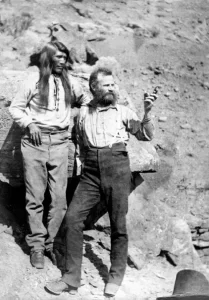
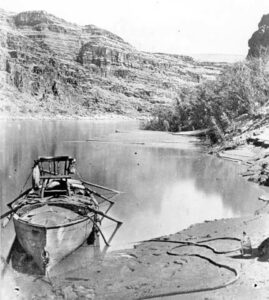 When John Wesley Powell began his expedition through the Grand Canyon he took eleven men with him. The plan was to explore the Grand Canyon by boat. Powell was a one-armed Civil War veteran and self-trained naturalist. The men had been on their expedition for about three months, when three of the men became very concerned about the safety of the mission. Some of the rapids had been heavy, and just ahead, they could hear what the worst of the rapids. The three men, terrified of the rapids that lay ahead, were convinced that they would have a better chance of survival, if they scaled the steep cliffs to the plateau above and walked out.
When John Wesley Powell began his expedition through the Grand Canyon he took eleven men with him. The plan was to explore the Grand Canyon by boat. Powell was a one-armed Civil War veteran and self-trained naturalist. The men had been on their expedition for about three months, when three of the men became very concerned about the safety of the mission. Some of the rapids had been heavy, and just ahead, they could hear what the worst of the rapids. The three men, terrified of the rapids that lay ahead, were convinced that they would have a better chance of survival, if they scaled the steep cliffs to the plateau above and walked out.
It would be hard to fault the men. When the party heard the rapids, they pulled to shore and walked down to see what lay ahead. Indeed, the worst was yet to come. Upon reaching the site of the rapids on foot, they saw, in the words of one man, “the worst rapids yet.” There was no argument from Powell, who wrote that, “The billows are huge, and I fear our boats could not ride them… There is discontent in the camp tonight, and I fear some of the party will take to the mountains but hope not.”
Indeed, the three men decided that they were not going to risk the rapids, so they scaled the cliffs…a move 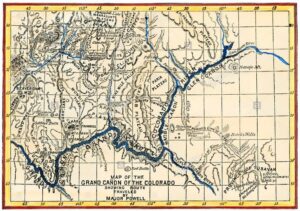 that turned out to be not only a serious mistake but a fatal one. It wasn’t their fault really. They truly thought that Powell’s plan to float the brutal rapids was suicidal. The men were convinced that Powell’s four wooden boats would have been smashed to bits in the punishing rapids…the kind that many would hesitate to run even with modern rafts.
that turned out to be not only a serious mistake but a fatal one. It wasn’t their fault really. They truly thought that Powell’s plan to float the brutal rapids was suicidal. The men were convinced that Powell’s four wooden boats would have been smashed to bits in the punishing rapids…the kind that many would hesitate to run even with modern rafts.
The next day, three of Powell’s men did leave. Convinced that the rapids were impassable, they decided to take their chances crossing the harsh desert lands above the canyon rims. So, on August 28, 1869, Seneca Howland, O G Howland, and William H Dunn said goodbye to Powell and the other men and began the long climb up out of the Grand Canyon. Once the three men left, the rest of the party steeled themselves to the ordeal that lay ahead, climbed into boats, and pushed off into the wild rapids.
While it seemed like a suicide mission, all of men survived the rapids, and the expedition emerged from the canyon the next day. Sadly, when he reached the nearest settlement, Powell learned that the three men who left had not been for fortunate. Allegedly, they encountered a war party of Shivwit Native Americans, and all 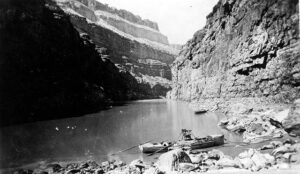
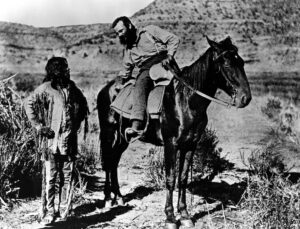 three were killed. Ironically, the three murders were initially viewed as more newsworthy than Powell’s amazing feat and the expedition gained valuable publicity. When Powell planned a second trip through the Grand Canyon in 1871, the publicity from the first trip insured that the second voyage was far better financed than the first. Sadly, the increased financing for the expedition came at great cost…to the three men who were murdered anyway.
three were killed. Ironically, the three murders were initially viewed as more newsworthy than Powell’s amazing feat and the expedition gained valuable publicity. When Powell planned a second trip through the Grand Canyon in 1871, the publicity from the first trip insured that the second voyage was far better financed than the first. Sadly, the increased financing for the expedition came at great cost…to the three men who were murdered anyway.

 As mining work started up in the United States, the need for housing in the area of the mines started up too. This need brought about the “company town” as a place where all or most of the stores and housing in the town are owned by the same company. Of course, this meant that quite often, all or most of the wages paid to workers, came back to the company in purchases, and as we all know stores and such always have a markup so that they make a profit. Still, they did meet a need, and there was often nowhere else to go. Company towns were often planned with a number of amenities such as stores, houses of worship, schools, markets, and recreation facilities.
As mining work started up in the United States, the need for housing in the area of the mines started up too. This need brought about the “company town” as a place where all or most of the stores and housing in the town are owned by the same company. Of course, this meant that quite often, all or most of the wages paid to workers, came back to the company in purchases, and as we all know stores and such always have a markup so that they make a profit. Still, they did meet a need, and there was often nowhere else to go. Company towns were often planned with a number of amenities such as stores, houses of worship, schools, markets, and recreation facilities.
The initial motive of building the “company towns” was to improve living conditions for workers. Nevertheless, many have been regarded as controlling and often exploitative. Others were not planned, such as Summit Hill, Pennsylvania, United States, one of the oldest, which began as a Lehigh Coal and Navigation Company mining camp and mine site nine miles from the nearest outside road. Just being that far from anything else around, was prohibitive to those who felt like they were the victims of gouging. Today, many of those “company towns” are ghost towns…lost to a bygone era.
One such town, the town of Kempton, West Virginia was located just a few feet inside the West Virginia border. This strategic location allowed the company to operate using scrip rather than cash. To me that seems like a move to a cashless system that further held the workers there, because the scrip was only accepted at the company businesses, thereby eliminating outside competition. As with any monopoly, this created price 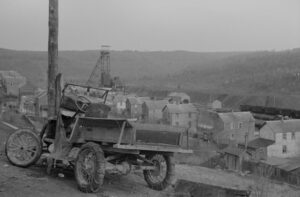 gouging. To make matters worse, if an employee needed a “big ticket” item, such as such as washing machines, radios, and refrigerators, they could get them and make payments. This put many miners in debt, and they were required to pay off the debt before they could move away. The town of Kempton was “founded in 1913 by the Davis Coal and Coke Company, a strip of land 3/4 of a mile long and several hundred feet wide was cleared for the construction of company houses, four to six rooms each with a front yard and a garden in the back. In 1915, J Weimer became the first schoolteacher at $40 a month with 53 pupils. The company store was located on the West Virginia side along with the Opera House that contained the lunchroom, bowling alley, pool table, dancing floor, auditorium, and the post office.” These towns were in reality, “privatized” towns run by a government that was neither elected nor fair, they were simply the ones in control, and if people wanted a job they dealt with the rules.
gouging. To make matters worse, if an employee needed a “big ticket” item, such as such as washing machines, radios, and refrigerators, they could get them and make payments. This put many miners in debt, and they were required to pay off the debt before they could move away. The town of Kempton was “founded in 1913 by the Davis Coal and Coke Company, a strip of land 3/4 of a mile long and several hundred feet wide was cleared for the construction of company houses, four to six rooms each with a front yard and a garden in the back. In 1915, J Weimer became the first schoolteacher at $40 a month with 53 pupils. The company store was located on the West Virginia side along with the Opera House that contained the lunchroom, bowling alley, pool table, dancing floor, auditorium, and the post office.” These towns were in reality, “privatized” towns run by a government that was neither elected nor fair, they were simply the ones in control, and if people wanted a job they dealt with the rules.
Cut out of the Appalachian wilderness, the town of Kempton flourished and became a vibrant community rich in culture and familial spirit. Then, when the mine closed in April of 1950, it just as quickly faded into oblivion. Nevertheless, the former residents tried to keep their connections alive. They held a reunion in 1952 to share their memories and to recall a strong sense of home. Unfortunately, what were once good intention, faded as life got busy and people moved around. Finally, the forest began to reclaim many of the houses as weeds took over and neglect allowed for decay. These days, the fruit trees and annual flowers that were planted long ago 
 by people who loved the place “still bloom to greet the Spring” and a few of the broken-down buildings still dot the landscape, if one in incline to look around. Newer homes have been built, that are privately owned, and mixed in are a few of the old remnants of times past. With mine reclamation laws in place now, groups have come in and performed archeological digs to recover old work items from the past and restore the site to historical status.
by people who loved the place “still bloom to greet the Spring” and a few of the broken-down buildings still dot the landscape, if one in incline to look around. Newer homes have been built, that are privately owned, and mixed in are a few of the old remnants of times past. With mine reclamation laws in place now, groups have come in and performed archeological digs to recover old work items from the past and restore the site to historical status.
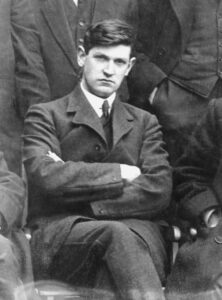
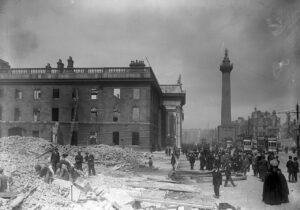 Like the United States, Ireland wanted to be free from the rule of the Britain…to become a sovereign nation. Also, like the United States, the British did not want to release Ireland. So began The Irish War of Independence also known as the Anglo-Irish War. The war was fought guerrilla warfare style in Ireland from 1919 to 1921 between the Irish Republican Army (IRA, the army of the Irish Republic) and British forces, which included the British Army, along with the quasi-military Royal Irish Constabulary (RIC) and its paramilitary forces the Auxiliaries and Ulster Special Constabulary (USC).
Like the United States, Ireland wanted to be free from the rule of the Britain…to become a sovereign nation. Also, like the United States, the British did not want to release Ireland. So began The Irish War of Independence also known as the Anglo-Irish War. The war was fought guerrilla warfare style in Ireland from 1919 to 1921 between the Irish Republican Army (IRA, the army of the Irish Republic) and British forces, which included the British Army, along with the quasi-military Royal Irish Constabulary (RIC) and its paramilitary forces the Auxiliaries and Ulster Special Constabulary (USC).
It was in the early part of the century, that a man names Michael Collins joined Sinn Fein, which was an Irish political party dedicated to achieving independence for all Ireland. The Sinn Fein party became the unofficial political wing of militant Irish groups in their struggle to throw off British rule from its inception. The idea of giving Ireland “Home Rule” was not a new one. It was first introduced in 1911, when the British Liberal government approved negotiations for Irish Home Rule, but the Conservative Party opposition in Parliament, combined with Ireland’s anti-Home Rule factions, defeated the plans. Then, with the outbreak of World War I, the British government tabled further discussion of Irish self-determination. It was then that Collins and other Irish nationalists responded by staging the Easter Rising of 1916.
In 1918, with the threat of conscription (conscription is the state-mandated enlistment of people in a national service, mainly a military service) being imposed on the island, the Irish people gave Sinn Fein a majority in national elections, and the party established an independent Irish parliament, Dail Eireann, which declared Ireland a sovereign republic. This was, of course, in direct rebellion against British rule. Collins led the Irish Volunteers, a prototype of the Irish Republican Army, in a widespread and effective guerrilla campaign against British forces in 1919. The war went on for another two years before a cease-fire was finally declared. Collins 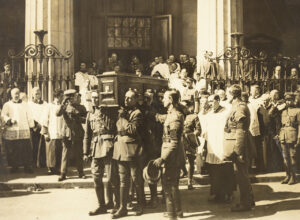
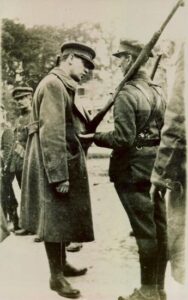 stepped up a one of the architects of the historic 1921 peace treaty with Great Britain, which finally granted autonomy to southern Ireland. Their work had finally paid off.
stepped up a one of the architects of the historic 1921 peace treaty with Great Britain, which finally granted autonomy to southern Ireland. Their work had finally paid off.
It seemed that maybe, finally all was finally right in Southern Ireland, and in January 1922, Sinn Fein founder Arthur Griffith was elected president of the newly established Irish Free State. Griffith appointed Collins to be his finance minister. Collins held the post until he was assassinated by Republican extremists in an ambush in west County Cork, Ireland on August 22, 1922. He was laid to rest in Dublin.
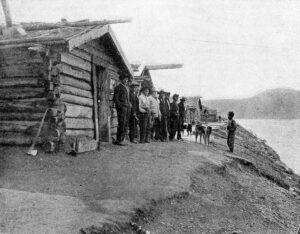
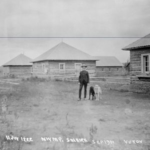 Fort Selkirk was built as a trading post on the Yukon River at the junction of the Pelly River in Canada’s Yukon. For many years it was home to the Selkirk First Nation, also known a Northern Tutchone. The Selkirk First Nation is a First Nation self-government in the Canadian territory, Yukon. “First Nation self-government is a formal structure through which Indigenous communities may control the administration of their people, land, resources, and related programs and policies, through agreements with federal and provincial governments. It is about First Nations taking greater control over and making their own decisions about matters that affect their communities within the Canadian constitutional framework. First Nations have their own governments with responsibilities, structures, resources, and taxation powers similar to other municipal or territorial governments in Canada. These First Nations are guided by their Final Land Claim Agreements, Self-Government Agreements, and Constitutions.” I suppose this would be similar to the Indian Nations in the United States, who are government entities in their own right.
Fort Selkirk was built as a trading post on the Yukon River at the junction of the Pelly River in Canada’s Yukon. For many years it was home to the Selkirk First Nation, also known a Northern Tutchone. The Selkirk First Nation is a First Nation self-government in the Canadian territory, Yukon. “First Nation self-government is a formal structure through which Indigenous communities may control the administration of their people, land, resources, and related programs and policies, through agreements with federal and provincial governments. It is about First Nations taking greater control over and making their own decisions about matters that affect their communities within the Canadian constitutional framework. First Nations have their own governments with responsibilities, structures, resources, and taxation powers similar to other municipal or territorial governments in Canada. These First Nations are guided by their Final Land Claim Agreements, Self-Government Agreements, and Constitutions.” I suppose this would be similar to the Indian Nations in the United States, who are government entities in their own right.
The trading post of Fort Selkirk was the hub of the community, allowing the buying, selling, and trading of  items needed for everyday life. Most of the people lived nearby, but these days, most of its citizens now live in Pelly Crossing, Yukon where the Klondike Highway crosses the Pelly River. The original language of the people was Northern Tutchone. These days, there is an effort to ensure that the language and culture are not lost. Archaeological evidence shows that the site has been in use for at least 8,000 years.
items needed for everyday life. Most of the people lived nearby, but these days, most of its citizens now live in Pelly Crossing, Yukon where the Klondike Highway crosses the Pelly River. The original language of the people was Northern Tutchone. These days, there is an effort to ensure that the language and culture are not lost. Archaeological evidence shows that the site has been in use for at least 8,000 years.
In 1848, Robert Campbell established a Hudson’s Bay Company trading post nearby, and in early 1852, he moved the post to its current location. This caused a lot of resentment due to the interference of the Hudson’s Bay Company with their traditional trade with interior Athabaskan First Nations. So, on August 21, 1852, the Chilkat Tlingit First Nation warriors attacked and looted the post. For a time, after the attack, the fort was in ruins. It was rebuilt about 40 years later and once again became an important supply point along the Yukon River.
The fort was basically abandoned again in the mid-1950s, after the Klondike Highway bypassed it and Yukon River traffic died down. These days it would be considered a ghost town I suppose. Nevertheless, many of the 
 buildings have been restored and the Fort Selkirk Historic Site is owned and managed jointly by the Selkirk First Nation and the Yukon Government’s Department of Tourism and Culture. That doesn’t mean that it has become a tourist hub, because the fact remains that there is no road access to the site. Most visitors get there by boat, though there is an airstrip, Fort Selkirk Aerodrome, at the site. A person would have to have a specific reason for going to the site, or they would be unlikely to make the journey.
buildings have been restored and the Fort Selkirk Historic Site is owned and managed jointly by the Selkirk First Nation and the Yukon Government’s Department of Tourism and Culture. That doesn’t mean that it has become a tourist hub, because the fact remains that there is no road access to the site. Most visitors get there by boat, though there is an airstrip, Fort Selkirk Aerodrome, at the site. A person would have to have a specific reason for going to the site, or they would be unlikely to make the journey.
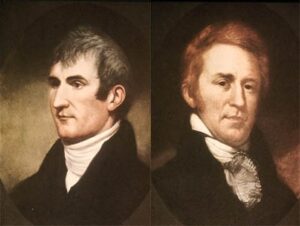
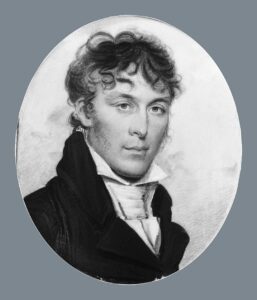 Exploration of new worlds is a journey that always has the potential to end in loss of life, and even disaster. The Corps of Discovery, also known as the Lewis and Clark expedition, was no different. The expedition was proceeding as planned, except for the fact that Sergeant Charles Floyd was feeling ill. The expedition left Saint Louis the previous May, enroute up the Missouri River with a party of 35 men, called the Corps of Discovery. Floyd was a native of Kentucky who had enlisted in the US military a few years earlier. When he heard that there was a call for volunteers to join the ambitious expedition across the continent to the Pacific, Floyd was one of the first men to apply. Floyd was the perfect choice for the program. He was young, vigorous, and better educated than most of the soldiers. The two co-captains not only selected him to join the mission, but they also promoted him to sergeant.
Exploration of new worlds is a journey that always has the potential to end in loss of life, and even disaster. The Corps of Discovery, also known as the Lewis and Clark expedition, was no different. The expedition was proceeding as planned, except for the fact that Sergeant Charles Floyd was feeling ill. The expedition left Saint Louis the previous May, enroute up the Missouri River with a party of 35 men, called the Corps of Discovery. Floyd was a native of Kentucky who had enlisted in the US military a few years earlier. When he heard that there was a call for volunteers to join the ambitious expedition across the continent to the Pacific, Floyd was one of the first men to apply. Floyd was the perfect choice for the program. He was young, vigorous, and better educated than most of the soldiers. The two co-captains not only selected him to join the mission, but they also promoted him to sergeant.
Unfortunately, Floyd’s perfect attributes could not keep him from becoming ill. As a result, his part in the great voyage of the Corps of Discovery was short-lived. In their journal, Lewis and Clark reported in July that Floyd 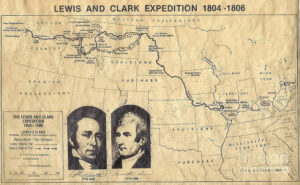 “has been very sick for several days. Then it appeared that he was getting better…for a time anyway. On August 15, he was “seized with a complaint somewhat like a violent chorlick [colic]… [and] he was sick all night.” The two captains were very concerned, and did what they could for Floyd, but they were far from what little medical help might have been available in 1804. Nevertheless, Floyd continued to grow weaker.
“has been very sick for several days. Then it appeared that he was getting better…for a time anyway. On August 15, he was “seized with a complaint somewhat like a violent chorlick [colic]… [and] he was sick all night.” The two captains were very concerned, and did what they could for Floyd, but they were far from what little medical help might have been available in 1804. Nevertheless, Floyd continued to grow weaker.
By August 19, 1804, Floyd’s illness was growing very severe during, and Clark sat up with the suffering man almost the entire night. Unfortunately, other than being with Floyd at the end, there was nothing that could be done. Floyd died in the early afternoon of August 19th, reportedly “with a good deal of composure.” The members of the expedition buried Floyd’s body on a high bluff overlooking a river that flowed into the Missouri. At the site, they placed a red-cedar post with his name, title, and date of death over the grave. Lewis read the funeral service, and the two captains concluded the ceremony by naming the nearby stream Floyds River and the hill Floyds Bluff in honor of their young comrade.
Lewis and Clark always regretted that they possessed such limited wilderness medical skills, because they were unable to cure the young soldier. Still, even if Floyd had been in Philadelphia, it is unlikely that the best doctors of the day would have been able to save him. From the journal telling of the symptoms, it is likely that Floyd 
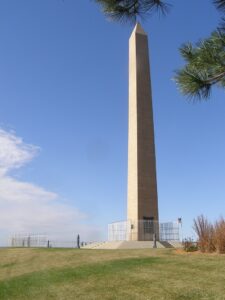 was suffering from acute appendicitis. His condition grew worse and worse, and when his appendix ruptured, he died quickly of peritonitis. Without modern antibiotic, and without the knowledge we have today of proper surgical procedures, there was simply no hope. Amazingly, Floyd’s was the only death the Corps of Discovery suffered in more than two years of dangerous wilderness travel. On their return journey from the Pacific in 1806, after a successful expedition, Lewis and Clark stopped at Sergeant Floyd’s grave to pay their respects.
was suffering from acute appendicitis. His condition grew worse and worse, and when his appendix ruptured, he died quickly of peritonitis. Without modern antibiotic, and without the knowledge we have today of proper surgical procedures, there was simply no hope. Amazingly, Floyd’s was the only death the Corps of Discovery suffered in more than two years of dangerous wilderness travel. On their return journey from the Pacific in 1806, after a successful expedition, Lewis and Clark stopped at Sergeant Floyd’s grave to pay their respects.
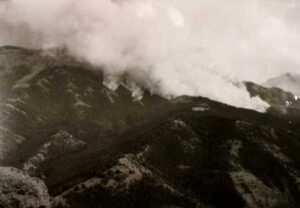
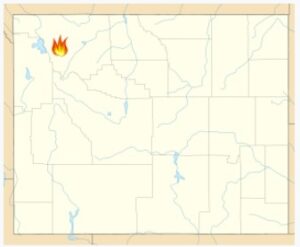 Lightning strikes are a major source of wildland fires. On August 18, 1937, a lightning strike in the Shoshoni National Forest, approximately 35 miles west of Cody, Wyoming, started the Blackwater Fire. During the course of fighting that fire, fifteen firefighters lost their lives when a dry weather front caused the winds to suddenly increase and change direction. The men were caught and had no way out. The fire spread quickly into the dense forest, creating spot fires, that trapped some of the firefighters in a firestorm. Nine of the firefighters died during the fire, while six others died from severe burns and respiratory complications a short time later. Another 38 firefighters were injured. The loss of US professional wildland firefighters from this fire was greater than any other fire in the 103 years between the Great Fire of 1910 and the Yarnell Hill Fire in 2013.
Lightning strikes are a major source of wildland fires. On August 18, 1937, a lightning strike in the Shoshoni National Forest, approximately 35 miles west of Cody, Wyoming, started the Blackwater Fire. During the course of fighting that fire, fifteen firefighters lost their lives when a dry weather front caused the winds to suddenly increase and change direction. The men were caught and had no way out. The fire spread quickly into the dense forest, creating spot fires, that trapped some of the firefighters in a firestorm. Nine of the firefighters died during the fire, while six others died from severe burns and respiratory complications a short time later. Another 38 firefighters were injured. The loss of US professional wildland firefighters from this fire was greater than any other fire in the 103 years between the Great Fire of 1910 and the Yarnell Hill Fire in 2013.
This was not what would be considered a large fire by wildland fire standards, burning only 1,700 acres of old-
 growth forest dominated by Douglas fir trees on the west slopes of Clayton Mountain, but it was by far one of the deadliest. The temperatures that day were about 90 °F, with a relative humidity was only 6 percent. Though most of the firefighters consisted of Civilian Conservation Corps (CCC) employees, they were led by more experienced United States Forest Service (USFS) fire managers. In the first half of the 20th century, firefighters used mostly hand tools to suppress wildfires, and all gear was carried by the firefighters or by pack animals. To further complicate matters, weather forecasting and radio communication were generally poor or nonexistent…leaving the firefighters virtually alone with the fire.
growth forest dominated by Douglas fir trees on the west slopes of Clayton Mountain, but it was by far one of the deadliest. The temperatures that day were about 90 °F, with a relative humidity was only 6 percent. Though most of the firefighters consisted of Civilian Conservation Corps (CCC) employees, they were led by more experienced United States Forest Service (USFS) fire managers. In the first half of the 20th century, firefighters used mostly hand tools to suppress wildfires, and all gear was carried by the firefighters or by pack animals. To further complicate matters, weather forecasting and radio communication were generally poor or nonexistent…leaving the firefighters virtually alone with the fire.
Following the deaths and injuries to the firefighters, the investigation and analysis of the fire and how it progressed, led the USFS to develop better ways to provide a more immediate response to combat fires. The development of the smokejumper program in 1939 was one of the major changes to came about from this fire. Another major change was the Ten Standard Firefighting Orders, a standardized set of wildland firefighting principles, were developed in 1957. “The Ten Standard Firefighting Orders are a set of systematically organized rules designed by a USDA Forest Service task force to reduce danger to personnel and increase firefighting efficiency.” They are: “1. Keep informed on fire weather conditions and forecasts; 2. Know what your fire is doing at all times; 3. Base all actions on current and expected behavior of the fire; 4. Identify escape routes and safety zones and make them known; 5. Post lookouts when there is possible danger; 6. Be alert. Keep 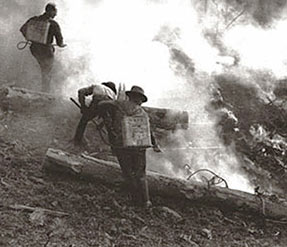
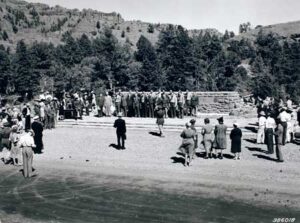 calm. Think clearly. Act decisively; 7. Maintain prompt communications with your forces, your supervisor, and adjoining forces; 8. Give clear instructions and ensure they are understood; 9. Maintain control of your forces at all times; 10. Fight fire aggressively, having provided for safety first.” There is no doubt that these rules and the smokejumpers program have saved countless lives. A year after the tragedy, survivors and their fellow employees constructed several memorials at the scene of the incident.
calm. Think clearly. Act decisively; 7. Maintain prompt communications with your forces, your supervisor, and adjoining forces; 8. Give clear instructions and ensure they are understood; 9. Maintain control of your forces at all times; 10. Fight fire aggressively, having provided for safety first.” There is no doubt that these rules and the smokejumpers program have saved countless lives. A year after the tragedy, survivors and their fellow employees constructed several memorials at the scene of the incident.
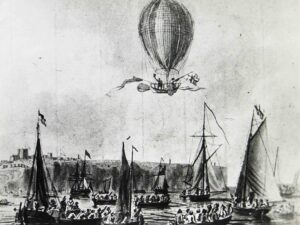 Even before the first airplane too flight, there were people who wanted to be airborne. Human flight first became a reality in the early 1780s with the successful development of the hot-air balloon by French papermaking brothers Joseph and Etienne Montgolfier. Soon balloons were being filled with lighter-than-air gas, such as helium or hydrogen, to provide buoyancy. It was a whole new era. Finally, on November 21, 1783, the first manned hot air balloon took flight. Man could be airborne and come back to earth safely. With that, came the natural desire to try to go higher and further. Man was not done with flight, and in fact this was just the beginning.
Even before the first airplane too flight, there were people who wanted to be airborne. Human flight first became a reality in the early 1780s with the successful development of the hot-air balloon by French papermaking brothers Joseph and Etienne Montgolfier. Soon balloons were being filled with lighter-than-air gas, such as helium or hydrogen, to provide buoyancy. It was a whole new era. Finally, on November 21, 1783, the first manned hot air balloon took flight. Man could be airborne and come back to earth safely. With that, came the natural desire to try to go higher and further. Man was not done with flight, and in fact this was just the beginning.
An early achievement of ballooning came in 1785 when Frenchman Jean-Pierre Blanchard and American John Jeffries became the first to cross the English Channel by air. While early manned flight did occur, it wasn’t the normal mode of transportation. In the 18th and 19th centuries, balloons were used more for military surveillance and scientific study than for transport or sport. As a mode of air travel, the balloon was replaced by the self-propelled dirigible, which was a motorized balloon, in the late 19th century.
While balloons were used for military purposes early on, by the early 20th century, interest in sport ballooning began to grow. Then, the inevitable was offered…an international trophy, to be offered annually for long- distance flights. Belgian balloonists were the dominate winners of these early competitions, but after World War II, new technology began to emerge, making ballooning safer and more affordable, By the 1960s hot air ballooning enjoyed widespread popularity. There were 17 unsuccessful transatlantic balloon flights from 1859 until the flight of the Double Eagle II in 1978. These resulted in the deaths of at least seven balloonists. One of the unsuccessful flights was in September 1977, when Ben Abruzzo and Maxie Anderson made their first attempt in the Double Eagle I. They were blown off course and forced to ditch off Iceland after traveling 2,950 miles in 66 hours. It was a brutal wait for rescue, and Abruzzo took several months to recover from frostbite that he suffered during the ordeal. Then, by 1978 he and Anderson were ready to try again. With the addition of Larry Newman as a third pilot. The men took off on September 11, 1978, in the Double Eagle II. The flight lifted off from Presque Isle, Maine.
distance flights. Belgian balloonists were the dominate winners of these early competitions, but after World War II, new technology began to emerge, making ballooning safer and more affordable, By the 1960s hot air ballooning enjoyed widespread popularity. There were 17 unsuccessful transatlantic balloon flights from 1859 until the flight of the Double Eagle II in 1978. These resulted in the deaths of at least seven balloonists. One of the unsuccessful flights was in September 1977, when Ben Abruzzo and Maxie Anderson made their first attempt in the Double Eagle I. They were blown off course and forced to ditch off Iceland after traveling 2,950 miles in 66 hours. It was a brutal wait for rescue, and Abruzzo took several months to recover from frostbite that he suffered during the ordeal. Then, by 1978 he and Anderson were ready to try again. With the addition of Larry Newman as a third pilot. The men took off on September 11, 1978, in the Double Eagle II. The flight lifted off from Presque Isle, Maine.
The 11-story, helium-filled balloon made good progress during the first four days, and the three pilots survived on hot dogs and canned sardines. Things seemed to be going perfectly this time. The only real trouble of the trip occurred on August 16, when atmospheric conditions forced the Double Eagle II to drop from 20,000 feet to a dangerous 4,000 feet. To ward off trouble, they jettisoned ballast material and rose to a safe height again. With the added altitude, they reached the coast of Ireland and on August 17 flew across England en route to their destination of Le Bourget field in Paris, which was the site of Charles Lindbergh’s landing after flying solo in a plane across the Atlantic in 1927. In a touching moment, their wives flew close enough to the balloon in a private plane as it traveled over England, to blow kisses at their husbands.

Double Eagle II was blown slightly off course toward the end of the journey, and they actually touched down just before dusk on August 17th, near the hamlet of Miserey, about 50 miles west of Paris. Their 137-hour flight set new endurance and distance records. The Americans were greeted by family members and jubilant French spectators who followed their balloon by car. That night, Larry Newman, who at 31 was the youngest of the three pilots, was allowed to sleep with his wife in the same bed where Charles Lindbergh slept after his historic transatlantic flight five decades before. Transatlantic balloon flight had finally been realized.
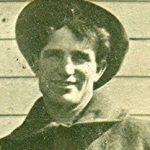
 My grandpa, Allen Luther Spencer, like most people worked at a number of jobs. The one I have heard the most about was his time with the Great Northern Railway, where he worked as a carpenter. That put him building and repairing the seats on the train cars, benches in the depots, and much more. Grandpa was an excellent carpenter. He built furniture for the family, including desks, and very likely beds, tables, and chairs. While being a carpenter on the Great Northern Railways might not seem like something exotic or even fun, it did allow him and his family, to travel from Holyoke, Minnesota to Superior Wisconsin so the kids could go to school and into town. Now, don’t think that my dad, Al Spencer and uncle, Bill Spencer demurely boarded the train each day, because they both decided that just boarding the train legally wasn’t the way to go. They
My grandpa, Allen Luther Spencer, like most people worked at a number of jobs. The one I have heard the most about was his time with the Great Northern Railway, where he worked as a carpenter. That put him building and repairing the seats on the train cars, benches in the depots, and much more. Grandpa was an excellent carpenter. He built furniture for the family, including desks, and very likely beds, tables, and chairs. While being a carpenter on the Great Northern Railways might not seem like something exotic or even fun, it did allow him and his family, to travel from Holyoke, Minnesota to Superior Wisconsin so the kids could go to school and into town. Now, don’t think that my dad, Al Spencer and uncle, Bill Spencer demurely boarded the train each day, because they both decided that just boarding the train legally wasn’t the way to go. They 
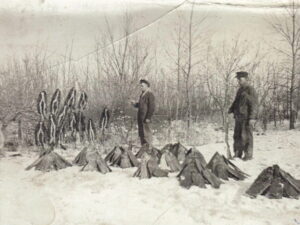 decided, rather that they would take a way to board that was a little bit more dramatic…namely hopping the train. Yes, they hopped on the moving train like they were hobos who shouldn’t be on there. Of course, that brough reprimands from railroad officials, and probably their parents too, but it didn’t stop them. Boys will be boys, I guess.
decided, rather that they would take a way to board that was a little bit more dramatic…namely hopping the train. Yes, they hopped on the moving train like they were hobos who shouldn’t be on there. Of course, that brough reprimands from railroad officials, and probably their parents too, but it didn’t stop them. Boys will be boys, I guess.
Grandpa also worked for a time in the oil fields in Texas, but I don’t know very much about that time in their family life. I know that my grandma, Anna (Schumacher) Spencer and my aunt, Laura (Spencer) Fredrick were there too during those years. Then the family returned to the Superior, Wisconsin – Duluth, Minnesota area and later to Holyoke, where the family 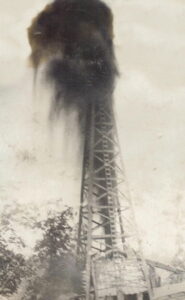
 would have a farm, while Grandpa worked on the railroad.
would have a farm, while Grandpa worked on the railroad.
Other jobs he had, were managing a hotel (which Grandma helped with), working in the logging business, the time that he and his brother-in-law, Albert Schumacher decided to go into the fur trade. They actually hunted skunks at one time. Imagine that!! It does go to show that they were determined to make a living, but they nearly froze to death while hunting. That was ultimately what made them decide to abandon the fur trade for the logging industry. Yes, it was an interesting life that my grandpa led. Today is the 145th anniversary of my grandpa, Allen Luther Spencer’s birth. Happy birthday in Heaven, Grandpa. We love you very much, and can’t wait to meet you in Heaven someday.
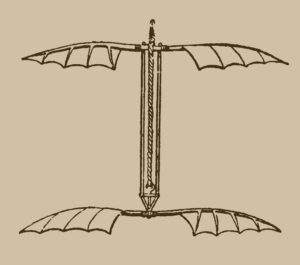
 Until I was listening to the story of the Wright Brothers again, I had never heard of Alphonse Pénaud. Born on May 31, 1850, Pénaud was a 19th-century French pioneer of aviation design and engineering. That seems odd, since the first airplane flight was the Wright Brothers in 1903. Nevertheless, Pénaud was the originator of a type of flight. Before the Wright Brothers took their first flight, they were inspired by Pénaud’s invention of the used of twisted rubber to power a model aircraft called a Planophore, and his 1871 model airplane, was the first aerodynamically stable flying model. He went on to design a full-sized aircraft with many advanced features but was unable to get any support for the project. The twisted rubber design was really more like a modern-day helicopter than a plane. Basically, what Pénaud succeeded in inventing was a toy…a copy of which ended in the hands of the Wright Brothers when their dad brought one home for them from a business trip.
Until I was listening to the story of the Wright Brothers again, I had never heard of Alphonse Pénaud. Born on May 31, 1850, Pénaud was a 19th-century French pioneer of aviation design and engineering. That seems odd, since the first airplane flight was the Wright Brothers in 1903. Nevertheless, Pénaud was the originator of a type of flight. Before the Wright Brothers took their first flight, they were inspired by Pénaud’s invention of the used of twisted rubber to power a model aircraft called a Planophore, and his 1871 model airplane, was the first aerodynamically stable flying model. He went on to design a full-sized aircraft with many advanced features but was unable to get any support for the project. The twisted rubber design was really more like a modern-day helicopter than a plane. Basically, what Pénaud succeeded in inventing was a toy…a copy of which ended in the hands of the Wright Brothers when their dad brought one home for them from a business trip.
Pénaud was born in Paris into a naval family, his father Charles Pénaud being an admiral in the French Navy. Pénaud had hip disease, which required that he walk with the aid of crutches, and also prevented him from being able to attend the Naval School. With that, Pénaud pursued other interests, and at age 20, he began 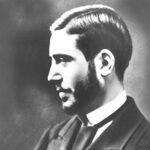 studying aviation. He joined the newly founded Société Aéronautique de France, and he became vice-president of the Society in 1876. He was a participant in the publication of the journal L’Aéronaute.
studying aviation. He joined the newly founded Société Aéronautique de France, and he became vice-president of the Society in 1876. He was a participant in the publication of the journal L’Aéronaute.
Pénaud excelled in developing model aircraft, and in 1870, made the first of a series of successful model helicopters. While the principle of this was not new, Pénaud upgraded the prior models with the addition of the first use of twisted rubber to power a flying model. During the early years of the development of heavier-than-air flight, many experimenters were to use this method of propulsion for experimental models, including Lawrence Hargrave and AV Roe.
In 1872, he developed a rubber-driven ornithopter. Both the helicopter and the ornithopter enjoyed some success as toys, but this was not what Pénaud wanted to do with his work. In 1873 he started collaborating with an engineer named Paul Gauchot, and produced two designs for full-sized aircraft…the first in 1874 and the second in 1876. The 1876 aircraft was drawn in detail for the purpose of patenting the ideas it incorporated, and had many remarkably advanced features, including electrically operated elevators, a fully enclosed cabin for the pilot, a retractable undercarriage, and the use of a pair of propellers rotating in opposite directions to eliminate the torque reaction caused by a single propeller. Pénaud also participated in lighter than air experimentation, and produced a number of ingenious devices, including a differential barometer to show the rate of ascent or descent. He really was a great innovator, but he just couldn’t raise much interest in his work.
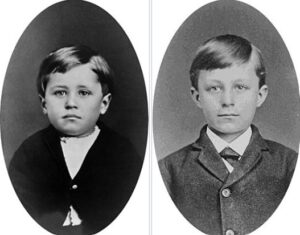
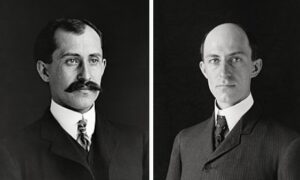 When Pénaud was unable to obtain any financial backing for his ambitious design. He gave up hope, and on October 22, 1880, at the age of 30, Pénaud committed suicide. Little did he know that twenty short years later, due in part to seeing his work, two preacher’s boys would actually invent a “flying machine” that worked. I think it is incredibly sad that he didn’t live to see that day.
When Pénaud was unable to obtain any financial backing for his ambitious design. He gave up hope, and on October 22, 1880, at the age of 30, Pénaud committed suicide. Little did he know that twenty short years later, due in part to seeing his work, two preacher’s boys would actually invent a “flying machine” that worked. I think it is incredibly sad that he didn’t live to see that day.

